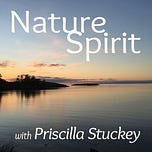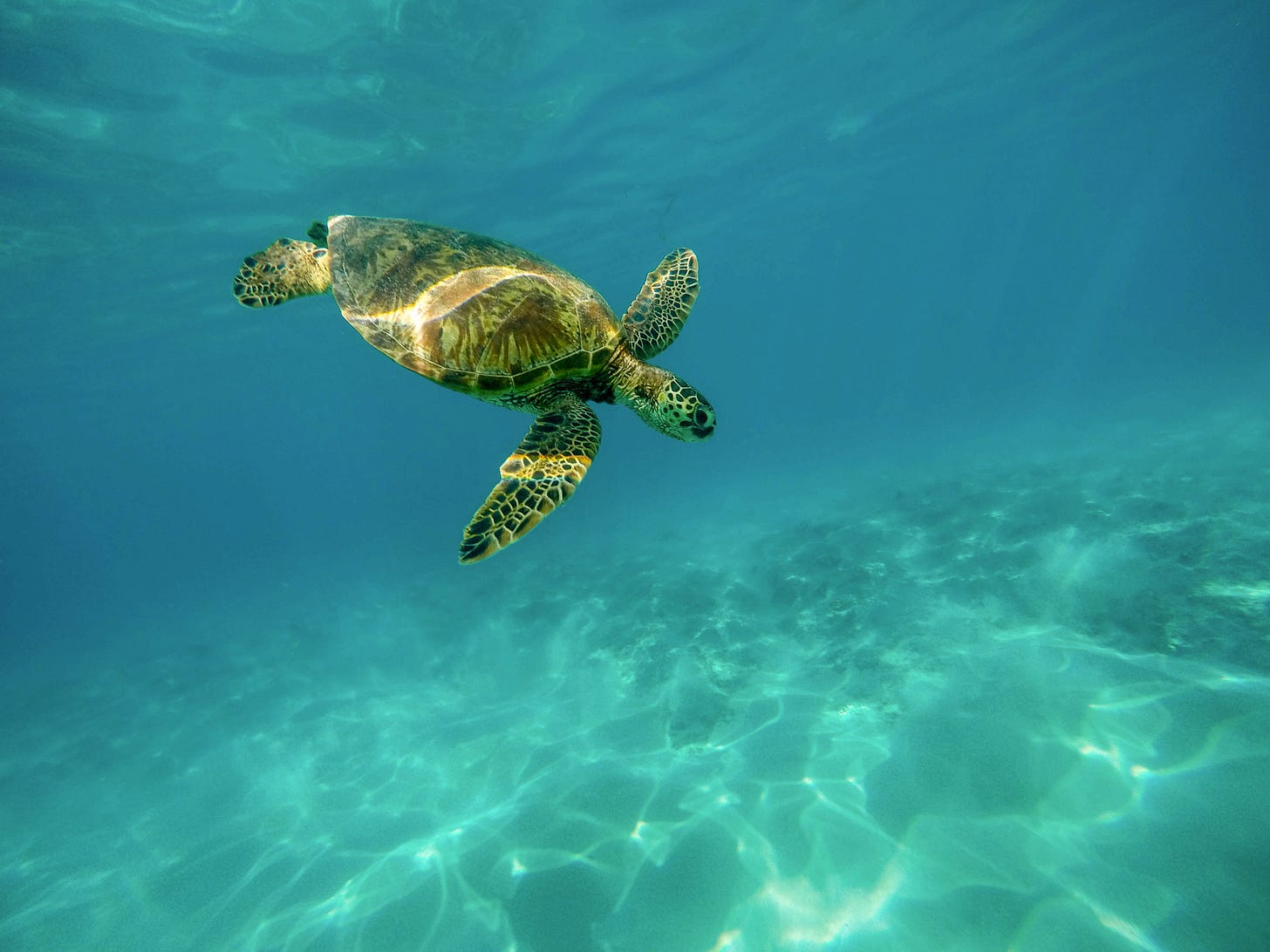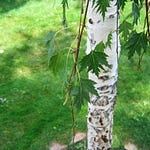Join me for a trip across our favorite reef, connecting with bright corals and colorful fish. That so much dazzling life—invisible from shore—becomes visible as soon as we wade in and turn our faces into the water provides a helpful way of thinking about the world of spirit, or the parts of reality that we can’t measure with our senses. How slicing reality into visible and invisible parts, as the Western world does, is a choice not shared by some other cultures, especially Indigenous ones. How Indigenous ways of knowing, or traditional ecological knowledges, involve not just learning about other beings but learning from them by listening to them, as Robin Wall Kimmerer says.
Transcript
We stand in waist-high waves and slip on our fins. The world around us is blue—a surface of rippling sapphire stretched out to the horizon. A lighter blue of sky above us, a few clouds drifting.
We jiggle our masks one last time to make sure they’re in place and bite down on our mouthpieces, and then we turn our faces into the water.
And it shocks me every time. This is more than the momentary shock of cold water hitting my face or the trickle of chilly water down my back before the wetsuit warms it up. This is the shock of leaving the familiar. We are visiting a different world. The world below the sea.
I lived near the Pacific for twenty years, gazing at it often. I knew its moods in sunny weather and in storms. I thought I knew the ocean. Then in my forties I snorkeled for the first time—and could hardly believe my eyes. So much dazzling life just below the waterline! And all of it invisible from the shore.
Now we live in Hawai’i, and wading into the sea is our connecting-with-nature practice. I used to head out on a familiar trail with binoculars, birdwatching. Now, clad in wetsuits, we gently kick across our favorite reef.
The reef fans out from the shore like a giant scallop shell, larger in every direction than a football field. We’ve covered it a hundred times, and yet we barely know it. Every swim holds surprises. Every trip across it is brand-new.
Splashed across the reef are bright colonies of corals and algae tinted every shade of yellow from sunshine gold to light lemon to a minty yellow-green. Between them, for contrast, other clumps and colonies of lavender and ice blue.
And the fish dart here and there flashing all the colors of the rainbow. Ornate butterflyfish in white with orange stripes swiped diagonally across their sides as if painted with fingers. Moorish idols in bold yellow and black, their one trailing thread of a fin always impossibly long and just as impossibly graceful. Tiny dark boxfish covered in white polka dots.
Even the most common fish on the reef is stunningly beautiful—the brown surgeonfish, or brown tang. Its name doesn’t come close to doing it justice—and that’s true of a lot of fish. Their common names might call out a single color, leaving out the thousand other hues or flashes of iridescence that you can see in the right twinkle of sunlight or the right twist of an agile tail. The brown tang are brown, yes, but also blue and pink and green and indigo. The tail always ends in a rich violet, and the dorsal fin, along the top edge of the body, gleams yellow-gold. The pelvic fin, along the bottom length, sports an edge of electric blue, a line that glows bright as a thread of neon light. Brown tang are some of the plainest fish on the reef, and they are glorious!
Under the sea, the life forms are strange and alien. Undeniably Other. I think of sea urchins, those balls of short dark venomous spines who rest quietly on the rocks. Sea urchins can see, but they don’t need eyes to do it. Instead, they use their feet. Tubular feet grow out from between the spines, all over the ball of their body, and the animal uses these feet to propel themselves around the reef. But the tips of these tube feet also hold light-sensitive cells that can form images. So the tube feet all together act something like a compound eye, making up a complete image so the animal can see.
And yet if so much of the life underwater is strange, it is similar as well. Recognizable. The fish have personalities. Some are shy, others bold. Some move quickly, others take their time. Green sea turtles have humanlike finger bones in their flippers.
So do dolphins and seals and whales, because the ancestors of all of them lived on land. A manta ray sweeps its magnificent triangular fins up and down to fly through the water, looking for all the world like an eagle pounding the air with slow and beautiful beats. The front edges of a ray’s fins sweep upward on each stroke while the rear edges flow downward, as if the ray were a fashion model trailing the most elegant sleeves.
I sometimes think about how, if I’d never turned my face into the ocean to snorkel that first time, it would have been like spending my life never having lifted the cover of a very important book. I knew the sea only by its surface—by its moods of calm blue-gray or stormy green. I had never cracked that cover to read the book itself. Yes, I watched whales, and I sailed on the surface of bays and oceans, but I met the world of water always from the perspective of air. I stayed on my side of the divide.
So turning my face into the water has become for me a useful way of thinking about another border that I’ve learned to cross, the border between what we think of as physical and as spiritual. I was trained as a scholar of religion, and for most of my adult life I gazed across the surface of spirituality as if it were a great ocean, studying various religious traditions, comparing their moods and motivations, but never exactly delving into that sea of spirituality myself. Never stepping fully away from the shore. Never quite placing my face in the water and opening my eyes below the surface to explore for myself what was actually there.
Because my culture didn’t want to go there. Didn’t believe in going there because we—the academics and scientists and scholars—believed that what lies on the surface is more trustworthy. And more real. Because, of course, when you’re gazing across the waves, the life below water is completely invisible. From the shore, or even a boat, you’d never guess so many civilizations are carrying on just out of sight. You can’t imagine the three-dimensional worlds below.
So in a parallel way, my culture has chosen to base its knowledge on the visible world only. To study only what we can know with the senses. To ignore, and even to place a taboo on, other ways of knowing and other parts of reality. It’s like staying on the surface of the ocean.
And there are some very good reasons for doing this. At least in theory, human beings should be able to agree on what our senses perceive. Western science is, after all, the process of discovering results that are true everywhere, for everyone. Yet these days we’re finding that people can deny even physical reality; we have trouble agreeing on even something so urgent and deadly as a virus. So maybe it’s understandable that when it comes to matters of spirit—of things that we can’t perceive with our physical senses—we just choose not to go there.
But we pay a price for limiting our attention to the material world, and especially for valuing that world above all. And that price is all wrapped up in the word value. Because when we ignore any world that can’t be measured through our senses, we lose sight of its deeper value. We lose sight, in other words, of the heart. For the less-visible world is the world of the heart. The world where love comprises the ultimate value. The world of respect and reciprocity, which lie beyond market worth.
And by losing sight of the heart, we fall out of love with the world that is our home. We come to regard the natural world, as Western society has done for a number of centuries, not as a community of beings to which we belong, a community that lives—or dies—together, but instead as a collection of so-called natural resources that exist for human consumption and exploitation. By losing touch with the heart, we fall into actions that deplete life instead of building it up.
It is worth remembering that dividing up the world into visible and invisible is a choice. A cultural choice. Many cultures, especially many Indigenous ones, do not slice up reality in this way. So Indigenous people might, for example, study plants as whole beings—not just where and how high a plant likes to grow physically, but also how a plant might interact in spirit by communicating with humans in languages of the heart—through dreams or visions.
Robin Wall Kimmerer, a member of the Citizen Potawatomi Nation who is a professor of botany in New York, puts this beautifully into words: “In Indigenous ways of knowing,” she says, “we say that we know a thing when we know it not only with our physical senses, with our intellect, but also when we engage our intuitive ways of knowing, of emotional knowledge and spiritual knowledge.” She goes on, “And that’s really what I mean by listening. By seeing that traditional knowledge engages us in listening. And what is the story that that being might share with us if we know how to listen as well as we know how to see?”
My culture has a lot to learn about listening. About learning from other beings, not just learning about them. I long for a society that recognizes these more complete ways of knowing—ways of knowing that engage the heart, ways of knowing that are often called intuitive or spiritual.
Because the heart is what we in the modern world have lost—the heart of connecting to other beings. The warm heart that would lead us to love and care for one another, both human and other-than-human. The warm heart that would stop us from using others up—depleting the air of its ability to give life or robbing the water of its refreshment—until we have destroyed the only foundations of life we will ever know.
This world of listening to other beings through heart and spirit is rich and colorful and satisfying. It is at least as dazzling and wonder filled as the universe I discovered when I waded into the ocean and turned my face into the water. And, like those bright underwater colonies of coral and algae and fish, it is completely hidden from sight if all we do is stand at the shore and gaze across the surface of the waves.
But, like the life of the reef, the life of spirit is available to any who decide to wade in a little, away from the familiar shore. And dip their faces into the water. And open their eyes.
So here’s wishing you visions of wonder and astonishment and a heart that can hear the wisdom of the living world.
For digging deeper
On sea urchins seeing without eyes: “Sea Urchins See with Their Feet,” Science Daily, June 12, 2018.
On the evolution of finger bones into fins in dolphins and turtles, seals and whales: “Dolphins Have Hidden Fingers,” by Cara Giaimo, in the New York Times this week.
For a truly deep dive into the strange world of sea creatures, Neal Agarwal’s “The Deep Sea” is an interactive adventure not to be missed. Just try scrolling through the depths without your jaw dropping.
Robin Wall Kimmerer’s luminous interview with Krista Tippett of On Being is “The Intelligence in All Kinds of Life.”
Echoes of Thomas Berry sound here, especially his famous sentence that “the universe is a communion of subjects rather than a collection of objects,” from Brian Swimme and Thomas Berry, The Universe Story.
I told my story of what happened when I finally waded into the sea of spirit in Tamed by a Bear.














Share this post